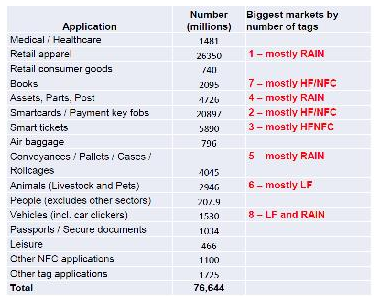Call Us Now
+8615914489090

1973 was a very pivotal year in the history of RFID development. The first two patents were approved in the United States, one for active RFID tags and the other for keyless entry systems. In the ensuing 20 years, RFID achieved rapid commercial expansion and widespread adoption in transportation, animal tracking, and various inventory-related applications in Europe and the United States. With the maturity of technology in the 1990s, a series of RFID standards appeared one after another. By the end of the last century, more than 1,000 RFID patents had been applied for worldwide.
2002 was another milestone year when NXP, Sony and Nokia introduced Near Field Communication (NFC) technology for contactless data transfer on low-power mobile devices , making this technology standard across all major brands of smartphones.
Nearly 50 years have passed since RFID's first patent application, but its adoption shows no signs of slowing down, with leading market data provider Statista predicting that the global RFID market will grow from $20 billion in 2020 to 2025 more than $44 billion annually. In this article, we will introduce some popular applications of RFID technology today, discuss some technologies related to RFID development, and explore the emerging applications that will drive the future development of RFID.
RFID has been widely used in many fields
Depending on the carrier frequency and coupling method, there are three main variants of RFID, each with its own advantages that can adapt RFID devices to different application scenarios. NFC, as a subset of RFID, operates in the high frequency (HF) range of the RFID spectrum.
In these three variants, the technology trend is that tags are getting smaller and the cost is plummeting, leading to the widespread adoption of RFID in a variety of applications. RFID and NFC are each geared towards different specific applications: RFID is item-centric, attaching an RFID tag to the item, enabling it to report its identity and other information to a computer network. NFC, on the other hand, has a very short range and is a user-centric technology that requires the deliberate involvement of the user to ensure that functions such as payments or building access are completed.
There are already tens of millions of RFID tags in use worldwide for a growing number of tasks, as shown in Table 2, which also identifies the most popular markets.

Table 2: Cumulative sales of all types of RFID tags by 2018. (Source: IDTechEx)
Important events to ensure the future development of RFID
NFC and RAIN have become the most popular RFID variants over time, and several recent developments have driven their popularity, including:
The RAIN RFID Industry Alliance was established in 2014 to facilitate the development of interoperable UHF RFID applications, thus paving the way for further development.
The rapid growth of the Internet of Things has created a huge demand for data generated by embedded sensors, and low-cost RAIN tags can provide basic intelligence to more "things".
In 2018, Apple announced that starting with the XR/XS models, all iPhones will be able to read NFC tags natively. As Android smartphones already have this capability, NFC is estimated to be used in approximately 2.2 billion mobile phones now, and will continue to unlock the full potential of NFC as multiple organizations continue to explore more and more applications.
The advent of low-cost, chipless RFID tags, capable of storing information in printable resonators and delay lines, and their implementation in flexible substrates, will enable RFID to gain more traction in new high-volume, cost-sensitive applications adoption.
These important developments ensure that RFID technology remains relevant in today's rapidly changing world, positioning it as a driving technology capable of supporting a growing number of applications.
The development potential of RFID
The above developments have created a solid platform for RFID RAIN and NFC technologies. The retail industry will continue to be the main application market for RAIN technology, with approximately 10 billion RFID tags adopted in the apparel industry in 2019. Contactless cards will also be another important driver for the development of RAIN technology, which includes applications such as contactless payment, transportation and secure access. Other areas expected to increase adoption of RAIN technology in the future include:
Animal tagging, which is a legal requirement in many countries, with 580 million tags adopted in 2019
Air baggage handling – The International Air Transport Association (IATA) now requires airlines to use RAIN technology to mark baggage
As an inexpensive technology, RAIN is able to turn many everyday objects into smart "things" that can be connected to the Internet of Things
A considerable number of smartphones in use worldwide are capable of supporting NFC, creating enormous potential for the growth of applications based on this technology.
Public transport has started to use NFC technology, which users can access with their mobile phones at the entrance, and the application is destined to expand rapidly around the world. In retail, brand owners are using NFC in smart packaging to create a "physical-digital" shopping experience. By tapping on products with embedded NFC tags, consumers can access everything from branded videos to social media product reviews.
In the automotive industry, manufacturers are also using NFC technology to enhance the user experience. High-end models such as BMW and Tesla are deploying NFC tags in their vehicles to enable many automated functions, including shared vehicle entry, driver setup, infotainment system customization, and more.
Finally, in the medical field, NFC technology is also well suited for implantable devices, which must be very energy efficient, saving as much power as possible, since they have to stay in the body for several years. For these applications, practitioners can use the barcode reader to activate the tag only when necessary, and wireless charging is also possible.
These are just a few examples of the innovative applications that are emerging through RFID RAIN and NFC technology, and as RFID tags shrink in size and cost, more applications will appear in more fields in the future.